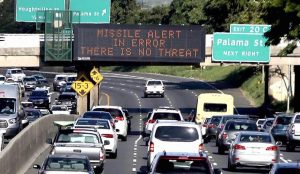by Timothy Kyle

The morning of Saturday, Jan. 13 residents of Hawaii were awoken by a text alert bearing this message: “BALLISTIC MISSILE THREAT INBOUND TO HAWAII. SEEK SHELTER. THIS IS NOT A DRILL.” Across the state, panic set in among citizens and vacationers alike. Videos have emerged of desperate parents hiding children in storm drains and basements, while others have blamed the alert for causing massive heart attacks in loved ones. According to the Honolulu Police Department, 911 calls spiked as cars crashed and people suffered anxiety attacks and cardiac arrest.
However, there was no incoming ballistic missile. The state of Hawaii hung in limbo, completely shut down, waiting for the apocalyptic fireball that never came. Only when the government issued a counter-notification 38 minutes later did people finally relax.
An event like this is a rare but dangerous thing. The state said that the error in sending the announcement was human, the wrong button was pressed during a routine procedure at the state’s emergency management headquarters. In our current geopolitical climate, where for the first time in 25 years the threat of a nuclear exchange looms, false alarms set a bad precedent. North Korea’s nuclear missile tech is becoming increasingly advanced and, with the range to now attack the continental US, people must be ready for the worst.
Preparedness may include vulnerable areas holding drills, but only if it’s made clear that they are drills. The Hawaii false alarm could have a dangerous “boy who cried wolf” effect. If a real missile was inbound and the same text alert was sent out, many people may not take it seriously and thus not take the appropriate action to survive. The alarm also uncovered a fear lurking just below the surface of the national psyche, one that has been bolstered by cavalier pro-war rhetoric by the current administration. The threat of nuclear war, dead and buried since 1991, is back. Those that lived through the Cold War must have a sense of sick deja vu; for the second time in history, one bad move and the world could be quite literally ended with the push of a button.
The panic this false alarm caused revealed this fear, because for 38 minutes, everyone in Hawaii thought the threat was real. This represents a failure of the basic role of an administration: to shepherd and lead, not terrify. The mass panic associated with the Hawaii alarm only occurred because of the fiery rhetoric being used by the president and other lawmakers.
There is one conclusion to be drawn from this false alarm: it cannot happen again. Emergency management organizations should take every precaution in the future to prevent similar events, whether it be through better training of human workers or added layers of redundancy. There can be no more fake ballistic missile threats; in the case of a real attack, the “cry wolf” effect could have serious and deadly implications.
Timothy Kyle, FCRH ’21, is a political science major from West Hartford, Connecticut.




































































































































































































